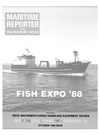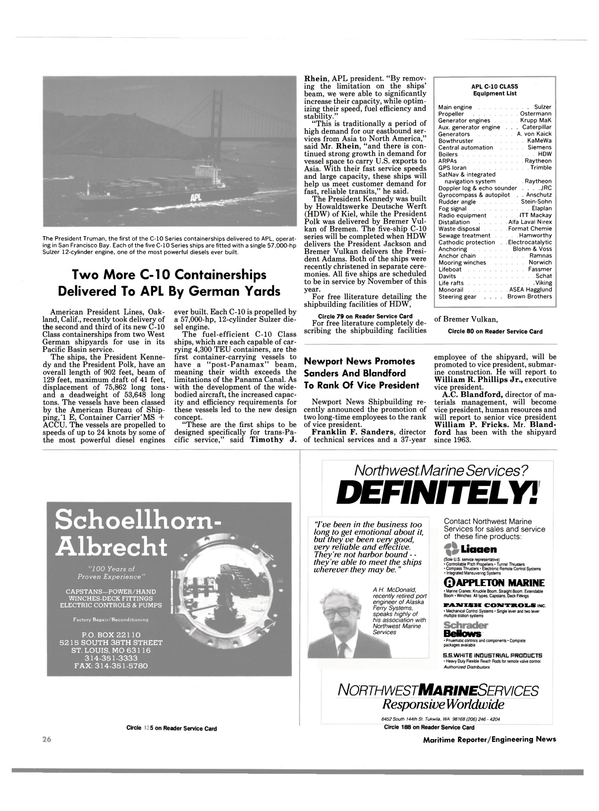
Matson Navigation Requests Bids From Three U.S. Shipyards To Build RO/RO Containership
Avondale, Bethlehem-Sparrows Point & NASSCO To Bid The domestic merchant marine shipbuilding industry recently received a boost when shipowner Matson Navigation Company, San Francisco, Calif., requested bids from three United States shipyards for construction of a combination lift-on, lift-off containership/rollon, roll-off (RO/RO) carrier. The vessel would be delivered in late 1991, according to company president M.S. Wasacz.
Matson has requested bids from the Shipyard Division of Avondale Industries, Inc., Avondale, La.; Bethlehem Steel Company's Sparrows Point, Md., shipyard; National Steel & Shipbuilding Co., San Diego, Calif.
According to Arthur J. Haskell, senior vice president, engineering and marine operations, the three yards were selected based on their ability to submit design proposals to meet Matson's requirements, interest and intended approach to the project and financial capabilities.
Matson has asked for bids and specifications by January 18, 1989, for construction of a slow-speed diesel- powered vessel of about 780 feet in length, with a beam of 105-1/2 feet, and capacity for 1,600 containers (24-foot equivalents), 500 automobiles and 1,800 short tons of molasses.
The vessel is intended for Matson's West Coast-Hawaii service.
Under the Jones Act of 1921, all vessels intended for use in the domestic market must be constructed in U.S.
shipyards.
The single-screw vessel is expected to be powered by a diesel engine in the "40,000-horsepower range." She will have a service speed of about 22.5 knots and a maximum speed of 23.5 knots and will be able to carry 400 refrigerated containers.
Based on developments in the container industry, the ship will have the flexibility to accommodate containers of various sizes up to 48 feet in length.
The RO/RO section at the after end will include a 500-car enclosed garage and capacity for trailers and oversized vehicles.
According to Mr. Haskell, Matson intends to construct the vessel with funds from the Capital Construction Fund, and they have informed the Maritime Administration of their intentions.
The Capital Construction Fund (CCF) Program was established under the Merchant Marine Act of 1970. It assists operators in accumulating capital to build, acquire and reconstruct vessels through the deferral of Federal income taxes on certain deposits, as defined in Section 607 of the Merchant Marine Act, 1936, as amended.
The CCF program enables operators to build vessels for the U.S. foreign trade, Great Lakes, noncontiguous domestic trade (e.g., between the West Coast and Hawaii) and the fisheries of the U.S.
Matson Navigation is a Capital Construction fund holder.
"This program is a logical add-on to the growth in our trade," said Mr.
Haskell. "We will need the additional capacity based on our projections for 1991. She should take care of our needs into the early 1990s," he said.
Matson currently operates a fleet of six modern vessels, including four containerships and the combination container-trailer carriers Matsonia and Lurline.
For free literature describing the services of Matson Navigation, circle 94 on Reader service card
Read Matson Navigation Requests Bids From Three U.S. Shipyards To Build RO/RO Containership in Pdf, Flash or Html5 edition of October 1988 Maritime Reporter
Other stories from October 1988 issue
Content
- Campbell Receives Order For Three 'Super Pacific' Tuna Purse Seiners page: 5
- Workboat Division Of MonArk Boat Changes Name To SeaArk Marine— Key Personnel Changes Announced page: 6
- Columbian Rope Co. Offers Free Literature Detailing New Fiber Rope For Marine Use page: 6
- Caterpillar-Powered Passenger Ferry Delivered By Moss Point Marine To State Of North Carolina page: 7
- General Ship Repair To Build Tender/Breaker Under $921,320 Contract page: 8
- Carnival Acquires Majority Of Admiral, RCCL For $550 Million page: 8
- P&O Purchases Sitmar Cruises For $210 Million page: 9
- Intertrade Awarded Navy Contract To Supply Messenger/Position Buoys page: 10
- HHI Wins $230-Million Offshore Project For ONGC In India page: 10
- Trinity Marine Group To Build Navy Oceanographic Research Ship page: 11
- Deck Machinery And Cargo-Handling Equipment page: 12
- FISH EXPO '88 page: 22
- Two More C-10 Containerships Delivered To APL By German Yards page: 26
- Okabe Offers Mil-Spec Fasteners Stocking And Mill Shipment Program page: 29
- G. Marine Diesel Leases Brooklyn Navy Yard Facilities page: 30
- Slaughter Joins Butterworth Tank Cleaning Machines page: 31
- World's Largest Monohull Crane Ship To Be Outfitted At McDermott Yard page: 34
- Bardex Views Contract Activity As Sign Of Offshore Improvement page: 35
- Cummins-Powered Crewboat Being Built At Matsumo Yard For Esso Resource Canada page: 36
- Matson Navigation Requests Bids From Three U.S. Shipyards To Build RO/RO Containership page: 37
- Advanced Deck Cranes From O&K Shorten Berthing Times, Cut Costs page: 38
- GASTECH 88 page: 40
- Fire-Damaged Crabber 'Reborn' After Conversion At MARCO-Seattle Yard page: 41
- 'Consolidation And Expansion' Will Be Theme Of Seatrade's Cruise Shipping '89 page: 42
- AESA Wins Orders From Cuba, Sweden; Will Build Seven Ships page: 43
- Free Literature Offered On High-Tech Multi-Pak Marine Trash Compactors page: 43
- Upgraded MAN B&W L28/32 Engine Offers Improved Fuel Economy, Reliability And Durability page: 44
- Unitor Offers Free 14-Page Brochure On Ship Services & Products page: 45
- New RAY-152 SSB Radiotelephone From Raytheon Provides Outstanding Long-Range Communication page: 46
- L'Orange Offers Free Literature On Engine Injector Systems page: 46
- Liquefied Gas Shipping— New Drewry Report Predicts Continued Improvement page: 47
- Rados-Designed Research And Monitoring Vessel Being Built By Knight & Carver In San Diego page: 48
- Rauma-Repola Deck Machinery And Aquamaster Propulsion Join Forces In New Company page: 48
- Golar Marine Incinerators Detailed In Free Literature page: 49
- Barco's '88-89 Catalog Of Impellers Includes 2 New Elastomer Cam/Pumpliners page: 49
- Trinity Marine Group Acquires Assets Of Guarino & Cox, Naval Architects page: 54
- Wartsila Diesel Announces Personnel Appointments page: 57
- HHI Wins Contract To Build LPG Carrier For Kosan Fleet Of Denmark page: 58


